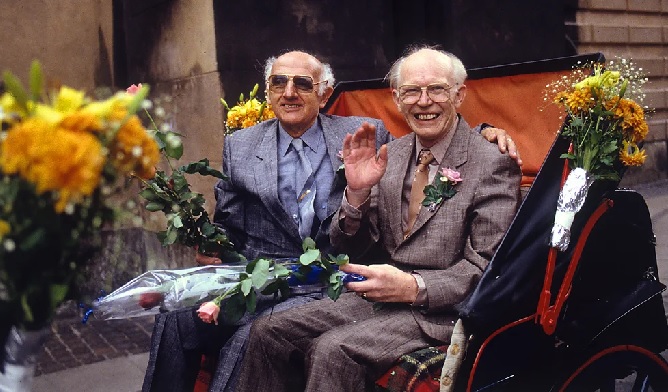
When Denmark held the first ever same-sex marriage in 1989
Denmark became the world's first country to offer legal recognition of gay partnerships on 1 October 1989, and the BBC was there to film the ceremonies – recording a day when "something shifted in human affairs".
In 2024 it might seem unremarkable in many parts of the world, but in 1989 it was a plunge into the unknown. Denmark's parliament passed a law in May of that year that allowed gay people to enter registered partnerships.
Five months later, 11 couples arrived suited and booted at Copenhagen's city hall to take part in a civil ceremony unlike any that had gone before. It wasn't quite the same step as marriage, but it was a giant leap for equality.
The very idea was so unusual at the time that the BBC's religion and ethics programme, Heart of the Matter, was on hand to film the proceedings.
Joan Bakewell, the programme's presenter, summarised the debate: "What lies at the heart of the matter is if one country ceases to regard marriage as solely between one man and one woman, how does that affect the way the rest of us think of it?
And if one country in Europe can pass such a law, wouldn't it eventually affect Britain?" It would take another 16 years for her second question to be answered.
The ceremony itself was in many ways just like a regular wedding. The couples entered a small room and were asked by the mayor if they wanted to be in partnership with each other.
The first couple to sign on the dotted line were Axel and Eigil Axgil, who had lived together for 41 years.
The veteran gay rights campaigners had in the past endured discrimination and ill-treatment. In 1948, the men – using their original names Axel Lundahl-Madsen and Eigil Eskildsen – founded the Danish Gay and Lesbian Association. Legal recognition of their partnership had been a long time coming. Upon their civil union, they combined their names into a new surname, Axgil.
The second of 11 couples entering civil partnerships that day were Ivan Larsen, an ordained minister of the Lutheran church, and psychologist Ove Carlsen.
Mr Larsen said he felt so happy that he could allow himself "to have the same feeling as everyone else who is going to be married".
He told the BBC: "It's the first time in world history it has been made possible for gays and lesbians – not to be married, because we are not allowed to use the word 'marriage' – but we are allowed to have our partnership registered with the same rights, except for a few things that the heterosexuals have. It is a kind of marriage. It means that now we are recognised not only as singles, but also as couples. That is extraordinary."
The civil partnerships differed in three significant ways from heterosexual marriage: at least one partner had to be a Danish citizen, couples were not allowed to adopt children and the union could not be registered in a church.
As a priest, however, Mr Larsen saw their union as much the same as a traditional Christian marriage.
"I think that when two people are in love with each other and they want to spend the rest of the life together, then it is a marriage blessed by God. Whether they are saying 'I do' in the church, at a town hall or in a private room, it's a Christian marriage, and God is blessing it."
The Aids crisis in the 1980s had made same-sex partnerships more of a pressing issue, according to Dorthe Jacobsen of the Danish Gay and Lesbian Association.
She said that when her organisation came forward to offer help to the authorities in reaching out to gay men, "that really started the people in parliament talking to us".
She added: "It meant they started to realise what kind of lives we had, and of course when you talk to people, they get to know you. They find out that you're not a pervert. They find out that you have a very similar life to them."
Leading the way
For Theodor Jørgensen, a theology professor at the University of Copenhagen, Denmark had taken an important step in leading by example.
"Some societies have to make the first step and to take the risk. All the homosexuals in all the countries over the world will come to their governments and say, 'Look what they have done in Denmark – we should try to do the same thing here, and what are your objections to it?'"
Northern European countries would lead the way in recognising same-sex unions. Norway, Sweden and Iceland all enacted similar legislation to Denmark in 1996, while Finland followed suit six years later.
The Netherlands became the first country to offer full civil marriage rights to gay couples in 2001. The UK held its first civil partnership ceremonies in 2005. In 2015, the US Supreme Court ruled that same-sex marriage was a legal right across the United States. To date, there are 36 countries where same-sex marriage is legal.
At the end of the 1989 documentary, Bakewell observed: "Something has shifted in human affairs. It began here in Denmark with a few couples on a sunny Sunday in October, where marriage and partnerships now live side-by-side. The rest of the world is watching."
In 2012, Denmark went one step further and legalised gay marriage. To mark the occasion, Mr Larsen and Mr Carlsen held a blessing of their union in a church.
Looking back in 2014 in an interview with the BBC's World Service, Mr Larsen said that Denmark's legalisation of same-sex partnerships had an enormous effect on normalising gay relationships.
"In fact, I sometimes think it has been so normal that it isn't worth discussing," he laughed.
